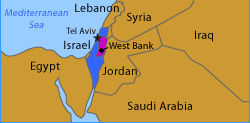Start date: 2003
Proposed length: Approximately 400 miles
Official purpose: Prevention of terrorism
Following war in 1967 between Israel and its Arab neighbors, Israel annexed the West Bank and Gaza Strip from Jordan and Egypt, respectively. The Israeli government encouraged Jews to settle there, and close to 200,000 Jews now live among more than two million Palestinians in the West Bank. (The Israeli government has announced plans to remove its troops and all 5,000 Jewish residents from the Gaza Strip in August 2005.) Israel has since exchanged land for peace with Jordan and Egypt, both of which have abandoned their claims to the West Bank and Gaza, respectively; they have agreed with Palestinian leaders that this land will compose the future state of Palestine. Since the mid-1990s, Israeli and Palestinian leaders have negotiated — in stops and starts — issues of land and security in the West Bank and Gaza Strip. The peace process is not without its detractors: some extremist Jews claim that the state of Israel should encompass the “Greater Israel” of biblical times, even if it means government by a Jewish minority; many extremist Palestinians reject any notion of a Jewish state, and have responded to talk of peace with hundreds of suicide bombings in Israel as well as the disputed territories; and a substantial number of moderates on both sides would like to see peace, but consider it unattainable.
Under the leadership of Prime Minister Yizhak Rabin, in 1994 Israel began construction of a security barrier between the Gaza Strip and Israel proper. After the wall was completed, the number of suicide attacks committed in Israel by Gaza residents dropped to nearly zero. The “second intifada” began in 2000, and a drastic increase in suicide bombings and other attacks rocked Israel and its settlements. Prime Minister Ariel Sharon eventually announced plans to build a security barrier along the West Bank border, and construction began in 2003. The barrier remains under construction, and plans for the final route have changed more than once. If completed, the final barrier will measure approximately 400 miles.
The Israeli government argues that the barrier has been indispensable in fighting terrorist infiltration, as terror attacks have dropped precipitously. But the barrier does not strictly follow the “Green Line” — the 1949 Armistice border that divides Israel and the West Bank — and reaches into the West Bank, encompassing some Jewish settlements. Palestinian leaders have argued that Sharon is attempting to impose “facts on the ground,” a de facto border that Israel will cite in future land negotiations. Israel has countered that the security barrier is not permanent (it is mostly chain-link fence and sensors), and that security and geographical considerations, not politics, have determined the route (the Israeli army, not the Sharon administration, mapped the barrier). In some areas, the wall has separated some Arab residents from nearby villages or workplaces. Israeli human-rights groups brought petitions against the barrier on behalf of Arab residents; in June 2004, Israel’s High Court of Justice found that a defensive security barrier is permissible in principle, but also cited specific instances in which the barrier harmed Arabs. The court ordered that portions of the barrier be rerouted, and the Sharon government agreed to abide the decision. The Israeli court, along with pressure by the United States and other countries, has led the Israeli government to change the route on several occasions. In July 2004, the International Court of Justice issued a nonbinding opinion against the barrier.
- Previous: Iraq/Kuwait
- Next: Morocco/Western Sahara



